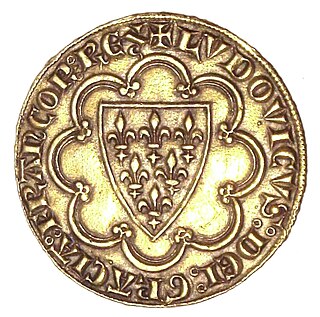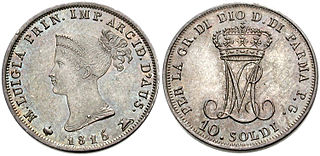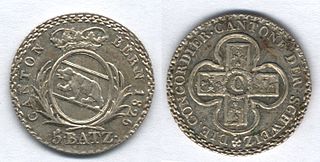
The Napoléon is the colloquial term for a former French gold coin. The coins were minted in denominations of 5, 10, 20, 40, 50, and 100 francs. This article focuses on the 20 franc coins issued during the reign of Napoléon Bonaparte, which are 21 mm in diameter, weigh 6.45 grams and, at 90% pure, contain 0.1867 troy ounces (5.807 g) of pure gold. The coin was issued during the reign of Napoleon I and features his portrait on the obverse. The denomination continued in use through the 19th century and later French gold coins in the same denomination were generally referred to as "Napoléons". Earlier French gold coins are referred to as Louis or écu. Gold Napoléons have historically proven more resilient than other gold coins to economic forces, such as after the Suez crisis when unlike other coins Napoléons did not weaken.

The Swiss franc is the currency and legal tender of Switzerland and Liechtenstein. It is also legal tender in the Italian exclave of Campione d'Italia which is surrounded by Swiss territory. The Swiss National Bank (SNB) issues banknotes and the federal mint Swissmint issues coins.

The franc, also commonly distinguished as the French franc (FF), was a currency of France. Between 1360 and 1641, it was the name of coins worth 1 livre tournois and it remained in common parlance as a term for this amount of money. It was reintroduced in 1795. After two centuries of inflation, it was redenominated in 1960, with each new franc (NF) being worth 100 old francs. The NF designation was continued for a few years before the currency returned to being simply the franc. Many French residents, though, continued to quote prices of especially expensive items in terms of the old franc, up to and even after the introduction of the euro in 2002. The French franc was a commonly held international reserve currency of reference in the 19th and 20th centuries. Between 1998 and 2002, the conversion of francs to euros was carried out at a rate of 6.55957 francs to 1 euro.

A Rappen originally was a variant of the medieval Pfennig ("penny") coin common to the Alemannic German regions Alsace, Sundgau, northern Switzerland and south-western Germany. As with other German pennies, its half-piece was a Haller, the smallest piece which was struck.

The lira was the currency of Italy between 1861 and 2002. It was introduced by the Napoleonic Kingdom of Italy in 1807 at par with the French franc, and was subsequently adopted by the different states that would eventually form the Kingdom of Italy in 1861. It was subdivided into 100 centesimi, which means "hundredths" or "cents". The lira was also the currency of the Albanian Kingdom from 1941 to 1943.

The term écu may refer to one of several French coins. The first écu was a gold coin minted during the reign of Louis IX of France, in 1266. The value of the écu varied considerably over time, and silver coins were also introduced.

The Kingdom of Italy was a kingdom in Northern Italy in personal union with Napoleon I's French Empire. It was fully influenced by revolutionary France and ended with Napoleon's defeat and fall. Its government was assumed by Napoleon as King of Italy and the viceroyalty delegated to his stepson Eugène de Beauharnais. It covered some of Piedmont and the modern regions of Lombardy, Veneto, Emilia-Romagna, Friuli-Venezia Giulia, Trentino, South Tyrol, and Marche. Napoleon I also ruled the rest of northern and central Italy in the form of Nice, Aosta, Piedmont, Liguria, Tuscany, Umbria, and Lazio, but directly as part of the French Empire, rather than as part of a vassal state.

The lira was the currency of the Kingdom of Sardinia between August 6, 1816, and March 17, 1861.
The lira austriaca was the currency of the Kingdom of Lombardy–Venetia.

The lira was the currency of the Papal States between 1866 and 1870. It was subdivided into 20 soldi, each of 5 centesimi.
The lira was the currency of the Republic of Lucca until 1800 and again of the Duchy of Lucca between 1826 and 1847. It was subdivided into 20 soldi, each of 3 quattrini or 12 denari.
The lira was the currency of the mainland part of the Kingdom of the Two Sicilies, known as the Kingdom of Naples, between 1812 and 1813.

The lira was the distinct currency of Parma before 1802 and again from 1815 to 1859.

The Frank was the currency of the Swiss canton of Aargau between 1798 and 1850. It was subdivided into 10 Batzen, each of 4 Kreuzer or 10 Rappen. It was worth 1⁄4th the French silver écu or 6.67 g fine silver.
The Basel frank was the currency of the Swiss canton of Basel between 1798 and 1850. It was worth 1⁄4th the French silver écu or 6.67 g fine silver.

The Frank was the currency of the Swiss canton of Berne between 1798 and 1850. It was subdivided into 10 Batzen, each of 10 Rappen. It was worth 1⁄4th the French silver écu or 6.67 g fine silver.
The Frank was the currency of the Swiss canton of Schaffhausen between 1798 and 1850. It was subdivided into 10 Batzen, each of 4 Kreuzer. It was worth 1⁄4th the French silver écu or 6.67 g fine silver.
The Frank was the currency of the Swiss canton of Solothurn between 1798 and 1850. It was subdivided into 10 Batzen, each of 4 Kreuzer or 10 Rappen. It was worth 1⁄4th the French silver écu or 6.67 g fine silver.
The Frank was the currency of the Swiss canton of Thurgau between 1798 and 1803. It was subdivided into 10 Batzen, each of 4 Kreuzer. It was worth 1⁄4th the French silver écu or 6.67 g fine silver.

Italy has a long history of different coinage types, which spans thousands of years. Italy has been influential at a coinage point of view: the medieval Florentine florin, one of the most used coinage types in European history and one of the most important coins in Western history, was struck in Florence in the 13th century, while the Venetian sequin, minted from 1284 to 1797, was the most prestigious gold coin in circulation in the commercial centers of the Mediterranean Sea.













